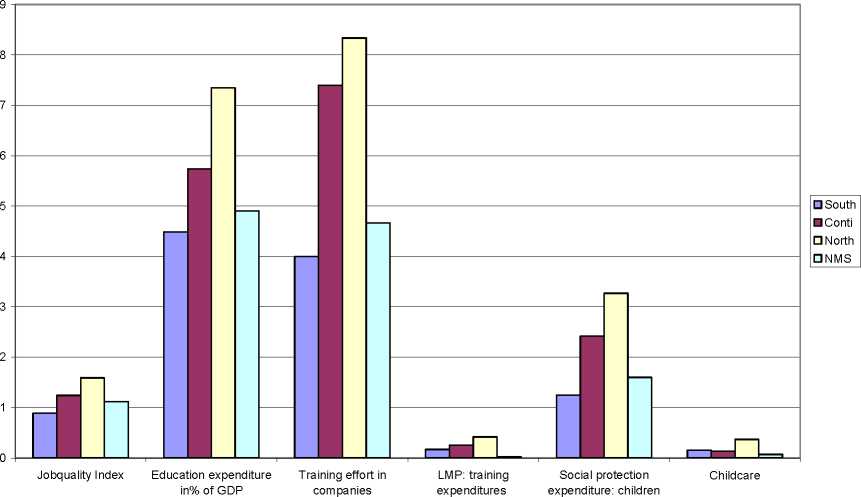Job quality and labour market performance | 7
hal-00616771, version 1 - 24 Aug 2011
Figure 4. Job quality and some public policy indicators, by cluster

and family
Source: Eurostat; Compendium, authors’ calculations.
3. Job quality and job quantity: Is there a trade-off?
Beyond this close relationship between employment performances and job quality clusters, there
are both theoretical and additional empirical arguments positively linking job quality and
employment rates or more general labour market performances. As far as economic literature is
concerned, such a positive relationship operates through several channels:
First, there are a number of well-known arguments linking human capital and economic growth.
Endogenous growth models show that human capital accumulation increases the growth rate
(Lucas, 1988). Investment in training and education yields increasing returns, generating
positive externalities, i.e. a higher level of education not only increases individual productivity,
but also the productivity of co-workers. There are also network effects, making a given amount
of training all the more effective as there are positive spill-over effects affecting other workers
in the network.
Second, there are also some links between workers’ security and economic growth. Security
must be understood here in a broad perspective, including job protection, but also safe working
conditions, fair wages and access to social protection. All these components of security in work
may increase productivity and labour market participation, and therefore favour growth and
labour supply. In addition, many security mechanisms work as automatic stabilisers, which are
particularly helpful during economic downturns. Increasing economic security in general - and
that of workers, in particular - can foster productivity growth. Thus, the various dimensions of
job quality can increase workers’ productivity and have a positive influence on economic
growth and employment creation.
Our empirical results tend to validate this positive view of the link between job quality and
quantity. The correlation between employment rates and some components of job quality is
positive and significant when longitudinal European data are used (see Table 2). In particular,
the employment rate is correlated with participation in education and training through the life
More intriguing information
1. The Folklore of Sorting Algorithms2. The Impact of EU Accession in Romania: An Analysis of Regional Development Policy Effects by a Multiregional I-O Model
3. The name is absent
4. El impacto espacial de las economías de aglomeración y su efecto sobre la estructura urbana.El caso de la industria en Barcelona, 1986-1996
5. Apprenticeships in the UK: from the industrial-relation via market-led and social inclusion models
6. AGRICULTURAL PRODUCERS' WILLINGNESS TO PAY FOR REAL-TIME MESOSCALE WEATHER INFORMATION
7. Inflation and Inflation Uncertainty in the Euro Area
8. Evidence-Based Professional Development of Science Teachers in Two Countries
9. The name is absent
10. Income Growth and Mobility of Rural Households in Kenya: Role of Education and Historical Patterns in Poverty Reduction